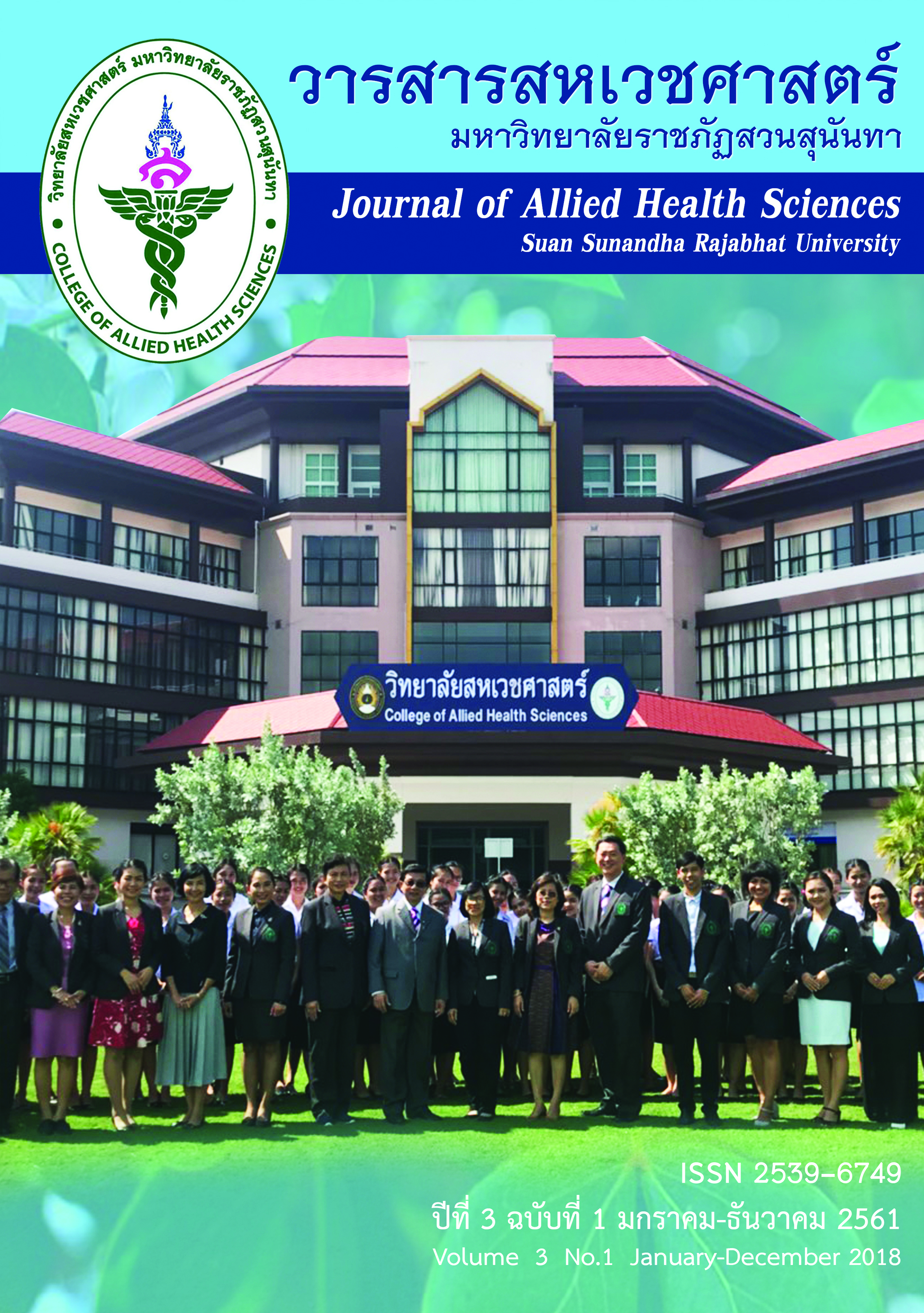การวิเคราะห์โครงร่างปีกเพื่อจำแนกชนิดและเพศของยุงพาหะนำโรค ในพื้นที่หมู่บ้านห้วยน้ำหนัก อำเภอสวนผึ้ง จังหวัดราชบุรี Outline-based geometric morphometric analysis for Identification of mosquito vectors in Huay nam nak Village of Ratchaburi province
Main Article Content
บทคัดย่อ
ยุงเป็นแมลงที่มีความสำคัญทางการแพทย์และสาธารณสุขเป็นพาหะนำโรคมาสู่มนุษย์ การควบคุมยุงพาหะแต่ละชนิดแตกต่างกันไปตามพฤติกรรมและแหล่งอาศัย การจำแนกชนิดของยุงมักเกิดปัญหาเนื่องจากยุงพาหะบางชนิดมีสายพันธุ์ที่ซับซ้อนและบางชนิดก็มีรูปร่างที่เหมือนกันมาก ซึ่งการจำแนกโดยวิธีปกตินั้นทำได้ยากลำบากทำให้เกิดปัญหาความผิดพลาดขึ้นและส่งผลทำให้เกิดความล้มเหลวในการควบคุมพาหะในพื้นที่ต่างๆ ปัจจุบันได้มีการนำเทคโนโลยีเข้ามาช่วยในการแก้ปัญหามากมาย รวมทั้งวิทยาการที่ทันสมัยในการจดจำและจำแนกวัตถุหรือสิ่งมีชีวิตเริ่มมีการนำมาประยุกต์ใช้ ซึ่งงานวิจัยนี้ได้นำเทคนิคสมัยใหม่ในการวิเคราะห์โครงร่างปีกมาทดลองใช้ในการแก้ปัญหา โดยมีวัตถุประสงค์เพื่อศึกษาประสิทธิผลในการจำแนกชนิดและเพศของยุงพาหะนำโรคในพื้นที่หมู่บ้านห้วยน้ำหนัก อำเภอสวนผึ้ง จังหวัดราชบุรี ในช่วงปลายฤดูฝน เดือนพฤศจิกายน พ.ศ.2560 การวิเคราะห์ครั้งนี้ใช้ยุงทั้งหมด 362 ตัว ประกอบไปด้วย ยุงก้นปล่อง 2 ชนิด ได้แก่ Anopheles barbirostris (van der Wulp) 48 ตัว และ An.subpictus (Grassi) 125 ตัว ยุงรำคาญ 3 ชนิด ได้แก่ Culex quinquefasciatus (Say) 22 ตัว Cx.whitmorei (Giles) 65 ตัว Cx.vishnui (Theobald) 24 ตัว ยุงลาย
2 ชนิด ได้แก่ Aedes aegypti (L.) 58 ตัว และ Ae.albopictus (Skuse) 20 ตัว ผลการทดลองพบว่า ปัจจัยด้านขนาดและรูปร่างเกือบทุกชนิดมีความแตกต่างกันทางสถิติ โดยการวิเคราะห์โครงร่างปีกมีประสิทธิภาพสูงในการจำแนกกลุ่มของยุงก้นปล่องพาหะนำโรคมาลาเรีย ซึ่งอยู่ในช่วง 84-91% รองลงมา คือ ยุงรำคาญพาหะนำโรคไข้สมองอักเสบเจอีและโรคเท้าช้าง ที่อยู่ในช่วง 63-83% แต่อาจไม่ค่อยดีนักสำหรับยุงลายพาหะนำโรคไข้เลือดออกและไข้ซิก้า สิ่งนี้เป็นหลักฐานสำคัญที่แสดงว่าการวิเคราะห์นี้สามารถนำไปช่วยในการจำแนกชนิดยุงก้นปล่องในประเทศไทยได้และสามารถนำไปพัฒนาเป็นโปรแกรมสำเร็จรูป (ทั้งในระบบมือถือและคอมพิวเตอร์) ที่ใช้หลักการนี้ไปวิเคราะห์ภาพปีก ซึ่งสิ่งเหล่านี้จะนำไปสู่การควบคุมยุงพาหะได้อย่างมีประสิทธิภาพ นำไปสู่การลดจำนวนของผู้ป่วยจากโรคติดต่อที่นำโดยยุงในพื้นที่ต่างๆ ต่อไป
Mosquito is important medical insect that transmit many disease to human especially in tropical and subtropical region. Each species of mosquito has different biology, behaviour, breeding site and epidemiological characteristics, which these information are useful in order to be the basis for planning to control the vector to suit species of mosquito in the area. Mosquito vector identification by morphological characteristic in the field has many obstacles because many mosquito species have similar morphology, cryptic species, sibling species and isomorphic species. Outline-based geometric morphometric or modern morphometric is a technique
to analyze shape and size. This research was study of outline-based of GM technique to separate species of mosquito in Huay nam nak Village as mosquito-borne diseases endemic area, Ratchaburi province, Thailand. Mosquito samples from collection in a field found Anopheles barbirostris (van der Wulp), An.subpictus (Grassi), Culex quinquefasciatus (Say), Cx.whitmorei (Giles), Cx.vishnui (Theobald), Aedes aegypti (L.) and Ae.albopictus (Skuse) which the total is 362 individuals. The results shown Outline-based geometric morphometric approaches can use identification in this area which are highly effective in Anopleles spp. For Aedes spp. as dengue vectors, it is not very effective but it can be used in some species. This technique has advantages including ease of use, low cost and quickness. It is very useful to use in the field which led to the successful way to control mosquito vectors.

